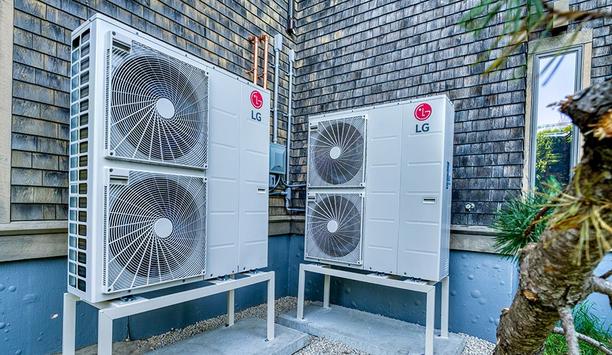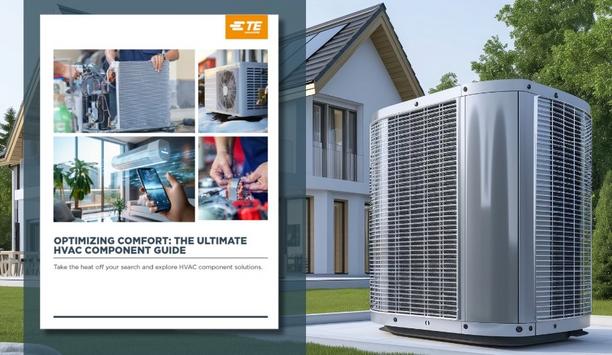UV Resources - Experts & Thought Leaders
Latest UV Resources news & announcements
The GLO™ UV‑C disinfection upper-room fixture series from UV Resources™ includes two new open-style luminaries designed to irradiate and inactivate airborne pathogens in occupied spaces with high ceilings (12-feet and taller). UV‑C coverage The GLO “open” fixtures for tall spaces direct UV energy upward and outward to create an intense zone of ultraviolet germicidal irradiation (UVGI) or UV‑C in the upper air. At the same time, occupants can safely go about their business in the lower portion of a room. This increase in irradiance levels translates to greater UV‑C coverage, enabling infection control specialists to treat more areas with fewer fixtures and saving both cost and energy. UV‑C disinfection treatment solutions UVGI energy disrupts the RNA/DNA in viruses and bacteria to prevent a pathogen from replicating and spreading infection These fixtures are ideal against droplet nuclei generated by coughing, sneezing, or talking as this expelled air rises to the upper area of a space where it is exposed to UV-C energy and infectious agents are inactivated. With UV‑C upper-room luminaries in place, the UVGI energy disrupts the RNA/DNA in viruses and the DNA in bacteria to prevent a pathogen from replicating and spreading infection. The GLO, which stands for Germicidal Light Overhead (GLO), provides upper-room UV‑C disinfection treatment solutions for spaces ranging from 150 to 1,500-square feet. The new additions to the GLO family, the open-style upper room luminaries, are offered in two models: GLO™ 900-OF, which treats about 900 square feet GLO™ 1500-OF, which treats about 1,500-square feet of space Like the GLO family’s three baffled or louvered-type luminaries ideal for rooms with ceilings at least 12-feet high, the new Open-style units use a parabolic reflector to optimize the germicidal UV‑C output of the fixture. The traditional baffle system is replaced by an adjustable extended “director” on the bottom of the fixture, which protects room occupants from stray UV‑C. Highest UV Output Both types of GLO fixtures; open and louvered offer excellent infection control capabilities by boosting UVGI output via an exclusive, computer-designed, high spectral, parabolic, aluminum reflector system that significantly reduces internal UV energy losses. The open design of the GLO upper-room UV-C luminaries allows for a wide field of UVGI far above occupants’ heads. This makes the unit highly effective inactivating pathogens in the upper-air space. Mitigates infection risk GLO open fixture is pending ETL approval and offers a three-year fixture and one-year lamp warranty The new open fixture can be easily installed anywhere to inactivate airborne viruses, bacteria, and mold spores. It is designed to mitigate the risk of nosocomial infections in locations with high ceilings, including high-bay warehouses, cafeterias, gyms, multipurpose rooms, museums, and other similar building types. According to the manufacturer, the new GLO upper-air UV Fixture exceeds the performance guidelines established by the U.S. Department of Health and Human Services and the Centers for Disease Control and Prevention (CDC) for hospital and healthcare applications. The GLO open fixture is pending ETL approval and offers a three-year fixture and one-year lamp warranty. How It Works Upper-room UV‑C systems (also known as upper-air) have been used to control airborne infectious diseases in high-traffic areas and where people congregate since the 1940s. Upper-room UV‑C fixtures utilize the natural rise-and-fall of convection or mechanical air currents to lift airborne infectious agents overhead, where they are exposed to UV‑C irradiation and inactivated. Airborne droplets containing infectious agents can remain in room air for at least three hours. Operating 24/7/365, UV-C and upper-room germicidal is a well-established technology that has proven effective as a public health intervention to prevent the spread of airborne diseases.
The GLO UV-C disinfection upper-room fixture series from UV Resources now includes two new open-style luminaries designed to irradiate and inactivate airborne pathogens in occupied spaces with high ceilings (12-feet and taller). The GLO ‘open’ fixtures for tall spaces direct UV energy upward and outward to create an intense zone of ultraviolet germicidal irradiation (UVGI) or UV-C in the upper air. At the same time, occupants can safely go about their business in the lower portion of a room. This increase in irradiance levels translates to greater UV-C coverage, enabling infection control specialists to treat more areas with fewer fixtures and saving both cost and energy. GLO UV-C disinfection upper-room fixtures The GLO UV-C disinfection upper-room fixtures are ideal against droplet nuclei, generated by coughing, sneezing The GLO UV-C disinfection upper-room fixtures are ideal against droplet nuclei, generated by coughing, sneezing, or talking, as this expelled air rises to the upper area of a space, where it is exposed to UV-C energy and infectious agents are inactivated. With UV-C upper-room luminaries in place, the UVGI energy disrupts the RNA/DNA in viruses and the DNA in bacteria, in order to prevent a pathogen from replicating and spreading infection. Upper-room UV C disinfection treatment solutions The GLO, which stands for Germicidal Light Overhead (GLO), provides upper-room UV C disinfection treatment solutions for spaces ranging from 150 to 1,500-square feet. The new additions to the GLO family, the open-style upper room luminaries, are offered in two models: GLO 900-OF, which treats about 900 square feet, and GLO 1500-OF, which treats about 1,500-square feet of space. Like the GLO family’s three baffled or louvered-type luminaries - ideal for rooms with ceilings at least 12-feet high, the new open-style upper-room fixture units use a parabolic reflector to optimize the germicidal UV-C output of the fixture. The traditional baffle system is replaced by an adjustable extended ‘director’ on the bottom of the fixture, which protects room occupants from stray UV-C. Highest UV Output Both types of GLO fixtures - Open and Louvered - offer excellent infection control capabilities, by boosting UVGI output via an exclusive, computer-designed, high spectral, parabolic, aluminum reflector system that significantly reduces internal UV energy losses. The open design of the GLO upper-room UV-C luminaries allow for a wide field of UVGI, far above occupants’ heads. This makes the unit highly effective inactivating pathogens in the upper-air space. Easy installation The new open fixture can be easily installed anywhere to inactivate airborne viruses, bacteria, and mold spores The new open fixture can be easily installed anywhere to inactivate airborne viruses, bacteria, and mold spores. It is designed to mitigate the risk of nosocomial infections in locations with high ceilings, including high-bay warehouses, cafeterias, gyms, multipurpose rooms, museums, and other similar building types. According to the manufacturer, the new GLO upper-air UV Fixture exceeds the performance guidelines established by the U.S. Department of Health and Human Services and the Centers for Disease Control and Prevention (CDC) for hospital and healthcare applications. The GLO open fixture is pending ETL approval and offers a three-year fixture, and one-year lamp warranty. How it works Upper-room UV-C systems (also known as upper-air) have been used to control airborne infectious diseases in high-traffic areas and where people congregate since the 1940s. Upper-room UV-C fixtures utilize the natural rise-and-fall of convection or mechanical air currents to lift airborne infectious agents overhead, where they are exposed to UV-C irradiation and inactivated. Airborne droplets containing infectious agents can remain in room air for at least three hours. Operating 24/7/365, UV-C and upper-room germicidal is a well-established technology that has proven effective as a public health intervention, in order to prevent the spread of airborne diseases. Product Summary The GLO upper-room UV-C disinfection fixture series from UV Resources now includes two new open-style luminaries, designed to irradiate air in occupied spaces with high ceilings (12-feet and taller). The high-output germicidal energy disrupts microbial RNA and DNA to prevent airborne pathogens from replicating and spreading infection. The GLO series offers affordable treatment solutions for spaces ranging from 150- to 1,500-square feet. Fixtures have been independently tested for safety and UV output.
The GLO UV-C disinfection upper-room fixture series from UV Resources now includes two new open-style luminaries designed to irradiate and inactivate airborne pathogens in occupied spaces with high ceilings (12-feet and taller). GLO ‘open’ fixtures The GLO ‘open’ fixtures for tall spaces direct UV energy upward and outward to create an intense zone of ultraviolet germicidal irradiation (UVGI) or UV-C in the upper air. At the same time, occupants can safely go about their business in the lower portion of a room. This increase in irradiance levels translates to greater UV-C coverage, enabling infection control specialists to treat more areas with fewer fixtures and saving both cost and energy. UV-C upper-room luminaries With UV-C upper-room luminaries in place, the UVGI energy disrupts the RNA/DNA in viruses and the DNA in bacteria These fixtures are ideal against droplet nuclei, which are generated by coughing, sneezing, or talking, as this expelled air rises to the upper area of a space, where it is exposed to UV-C energy and infectious agents are inactivated. With UV-C upper-room luminaries in place, the UVGI energy disrupts the RNA/DNA in viruses and the DNA in bacteria, in order to prevent a pathogen from replicating and spreading infection. Germicidal Light Overhead (GLO) light fixtures The GLO, which stands for Germicidal Light Overhead (GLO), provides upper-room UV-C disinfection treatment solutions for spaces ranging from 150 to 1,500-square feet. The new additions to the GLO family, the open-style upper room luminaries, are offered in two models: GLO 900-OF, which treats about 900 square feet, and GLO 1500-OF, which treats about 1,500-square feet of space. Like the GLO family’s three baffled or louvered-type luminaries, ideal for rooms with ceilings at least 12-feet high - the new Open-style units use a parabolic reflector to optimize the germicidal UV-C output of the fixture. The traditional baffle system is replaced by an adjustable extended ‘director’ on the bottom of the fixture, which protects room occupants from stray UV-C. High UV Output Both types of GLO fixtures - Open and Louvered - offer excellent infection control capabilities, by boosting UVGI output via an exclusive, computer-designed, high spectral, parabolic, aluminum reflector system that significantly reduces internal UV energy losses. The open design of the GLO upper-room UV-C luminaries allows for a wide field of UVGI far above occupants’ heads. This makes the unit highly effective inactivating pathogens in the upper-air space. New open fixtures offer easy Installation The new open fixtures can be easily installed anywhere to inactivate airborne viruses, bacteria, and mold spores The new open fixtures can be easily installed anywhere to inactivate airborne viruses, bacteria, and mold spores. It is designed to mitigate the risk of nosocomial infections in locations with high ceilings, including high-bay warehouses, cafeterias, gyms, multipurpose rooms, museums, and other similar building types. According to the manufacturer, the new GLO upper-air UV Fixture exceeds the performance guidelines, established by the U.S. Department of Health and Human Services and the Centers for Disease Control and Prevention (CDC) for hospital and healthcare applications. The GLO open fixture is pending ETL approval and offers a three-year fixture and one-year lamp warranty. Upper-room UV-C systems Upper-room UV-C systems (also known as upper-air) have been used to control airborne infectious diseases in high-traffic areas and where people congregate since the 1940s. Upper-room UV-C fixtures utilize the natural rise-and-fall of convection or mechanical air currents to lift airborne infectious agents overhead, where they are exposed to UV-C irradiation and inactivated. Airborne droplets containing infectious agents can remain in room air for at least three hours. Operating 24/7/365, UV-C and upper-room germicidal is a well-established technology that has proven effective as a public health intervention to prevent the spread of airborne diseases. High-output germicidal energy The GLO upper-room UV-C disinfection fixture series from UV Resources now includes two new open-style luminaries, designed to irradiate air in occupied spaces with high ceilings (12-feet and taller). The high-output germicidal energy disrupts microbial RNA and DNA to prevent airborne pathogens from replicating and spreading infection. The GLO series offers affordable treatment solutions for spaces ranging from 150- to 1,500-square feet. Fixtures have been independently tested for safety and UV output.
Insights & Opinions from thought leaders at UV Resources
During the coronavirus pandemic, UV-C systems have surged from a niche market to mass production capable of meeting historic demand levels. As a result, UV lamp manufacturers, as well as their component providers (e.g., glass suppliers), have struggled to meet the growing demand. Because of UV-C’s historic proven effectiveness, interest in and orders for UV disinfection equipment have increased exponentially during the COVID-19 pandemic. For example, in July, lighting manufacturer Signify (previously Philips Lighting), reported increasing “UV-C light source production capacity by a factor of eight.” The pandemic has settled in the affirmative the question of whether 254 nm germicidal wavelength can inactivate the genetic material in the SARS-CoV-2 virus (that causes COVID-19). acute respiratory syndrome Moreover, when aerosolized, the COVID-19-causing virus is likely to be more susceptible to UV-C damage than other coronaviruses such as SARS-CoV-1 (that led to the 2003 severe acute respiratory syndrome) or MERS-CoV (that caused the 2012 Middle East respiratory syndrome). Delivering doses of SARS-CoV-2 virus vaccine is one of the greatest logistical challenges ever undertaken The Centers for Disease Control and Prevention (CDC) and ASHRAE [American Society of Heating, Refrigerating and Air-Conditioning Engineers] have recommended UV-C as a technology that can “reduce the risk of dissemination of infectious aerosols in buildings and transportation environments.” The need for the technology continues. Delivering billions of doses of the SARS-CoV-2 virus vaccine is one of the greatest logistical challenges ever undertaken. airstream disinfection As of this writing, experts do not agree on the number of vaccinated individuals necessary to outright extinguish the COVID-19 pandemic. “As there is no clear end in sight, there is no foreseeable decline in the demand for the germ-killing and airstream disinfection benefits offered by UV-C,” says Daniel Jones, President, UV Resources, a pioneering company in ultraviolet-C (UV-C) equipment. Specifiers and HVAC contractors should not be deterred from recommending and specifying the proven benefits of UV-C disinfection systems, Jones contends, as the industry is rapidly adapting to what might likely be the “new normal” level of demand. “In other words, we expect commercial and residential demand for UV solutions to remain high due to their ability to efficiently inactivate the SARS-CoV-2 virus,” he says. pharmaceutical processing plants The company reports that disease-defeating UV-C surface and airstream technologies are especially popular with facility managers servicing hospitals and nursing homes, commercial offices, as well as food and pharmaceutical processing plants. Upper-room UV-C fixtures have been a "go-to" technology in the battle against the spread of COVID-19, among restaurants, school and university classrooms, airport screening areas, correctional facilities and community shelters. COVID-19 pandemic has ingrained the need for ongoing infection mitigation systems" Even after the pandemic subsides, demand for UV solutions will continue to remain high as perception of the technology has shifted to a health and safety need, says Jones. “Although the current pace of demand for germicidal UV-C solutions may decrease, the COVID-19 pandemic has forever raised awareness and ingrained the need for ongoing infection mitigation systems,” he comments. indoor air quality Despite nearly eight decades of research and thousands of applications in hospital emergency and operating rooms, urgent-care centers, universities, and first-responder locations, UV-C has previously not been widely leveraged. During the 1990s and 2000s, drug-resistant “superbugs” and hospital-acquired infections renewed interest in UV-C, known to kill virtually any microorganism, including antibiotic-resistant germs. The current pandemic, however, has laid bare the societal health outcomes offered by the proven germ-killing technology. While antibacterial UV-C applications have improved indoor air quality for decades, it was the pandemic that took the technology’s use in the eyes of building managers from energy savings to infection mitigation. air conveyance systems HVAC systems operate better, longer and users are happier when UV-C is installed in air conveyance systems Now, the market is starting to view UV-C along the same lines as air filtration - providing a cleaner, healthier environment which will result in a decrease in absenteeism. Additionally, HVAC systems operate better, longer and users are happier when UV-C is installed in air conveyance systems. Higher demand has produced supply challenges for these products. How can HVAC engineers best navigate equipment/parts supply shortages? Facility engineers and HVAC contractors would be well advised to place orders as early as possible and to accept partial-order shipments, says Jones. This will ensure that HVAC firms have the components/fixtures in-house (or even installed) once the lamps finally arrive. Jones advises specifying engineers who are unfamiliar with UV-C and who are conducting their due diligence should investigate the following points when choosing a supplier: Market Longevity - There are only a handful of companies that have been selling UV-C for HVAC/R for years. EPA Registration - Examine a device manufacturer’s registration with the US Environmental Protection Agency (EPA) as a pesticide device-producing establishment. Industry Credentials - Make sure products meet applicable safety standards and certifications (such as UL/CUL and CSA). Industry Participation - Look for manufacturers that routinely author technical articles, actively serve on regulatory and standards committees, and enjoy a solid industry reputation. surface disinfection system Selection of an air or surface disinfection system is based entirely on the application. UV Resources furnishes the following chart that summarizes the selection factors:
Since the coronavirus pandemic began, the ultraviolet irradiation industry has seen an unprecedented surge in demand for germicidal solutions. UV-C light is a short-wavelength, ultraviolet light that kills germs by inactivating a microorganism’s DNA. Germicidal UV-C energy is just one of three proven methods identified by ASHRAE of controlling airborne infection. The other two are ventilation and particle filtration. The pandemic has left no doubt that the 254 nm germicidal wavelength can inactivate the genetic material in the SARS-CoV-2 virus. Moreover, when aerosolized the COVID-19 causing virus is likely to be more susceptible to UV-C damage than other coronaviruses such as SARS-CoV-1 (that led to the 2003 severe acute respiratory syndrome) or MERS-CoV3 (that caused the 2012 Middle East respiratory syndrome). Proven, Mainstream Technology We have redoubled our educational focus and hired a communications manager to oversee these efforts" Therefore, it's incumbent on facility engineers to use multilayer preventative infection-control measures such as germicidal UV-C to help ensure that whatever pathogen is not “killed” by one method (say filtering or cleaning) is inactivated by another (UV-C). UV Resources, Santa Clarita, Calif., helped establish ultraviolet air and surface treatment as a mainstream technology. However, there is still a surprising amount of doubt and misinformation surrounding the application of UV-C technology, says Daniel Jones, President, UV Resources. “We have redoubled our educational focus and hired a communications manager to oversee these efforts,” he said. air distribution systems “While some bacteria and viruses are more susceptible to UV disinfection than others, all microorganisms tested do respond at the appropriate doses,” says Jones. “And, unlike antibiotics and vaccines, there is no way for microbes to develop a resistance to the germicidal energy of UV-C.” In-duct germicidal UV-C systems are installed in air-handling units or air distribution systems to inactivate microorganisms that propagate allergens and to disinfect moving airstreams “on-the-fly,” translating into better indoor air quality (IAQ), improved occupant productivity, and lower incidences of sick days. emergency waiting rooms Operating 24/7/365, upper-room germicidal fixtures can inactivate microbes in under a second A UV-C lamp system is a complete solution that includes a UV-C lamp, wiring harness or some means of connecting the lamp to an electronically-matched ballast, and can include accessories such as lamp/ballast monitors, safety switches, viewport/access doors and lamp timers. Upper-room germicidal UV-C fixtures — ideal for infection control — work by interrupting the transmission of airborne infectious diseases in high traffic communal areas. Immunocompromised and contagious individuals in emergency waiting rooms, urgent care facilities, doctor offices or senior living centers increase the potential for community spread by positioning potentially undiagnosed/untreated patients near others. upper-room germicidal fixtures The upper-room UV-C fixtures utilize the natural rise-and-fall of convection or mechanical air currents to lift airborne infectious agents above seven feet, where they are exposed to UV-C irradiation and killed. Operating 24/7/365, upper-room germicidal fixtures can inactivate microbes in under a second, including measles, mumps, TB, and cold viruses. These fixtures are wall-mounted and use baffles to direct the UV-C energy upward and outward ensuring that no UV-C energy enters the occupied portion of the room. Kill ratios of up to 99.9% on a first-pass basis have been modeled, and concentrations are further reduced by each subsequent pass of recirculated air (“multiple dosing”). The powerful GLO Upper-Room Germicidal Fixture from UV Resources delivers up to 350% more irradiance than conventional upper air UV systems elevate infection control “Healthcare and commercial office buildings have traditionally represented the early adopters of UV-C technology to disinfect airstreams, HVAC surfaces and the upper air,” says Jones. “The healthcare industry has once again led the surge in use of UV-C during this current pandemic. However, the unprecedented global impact of this pandemic will elevate infection control and life-safety issues to the forefront of vulnerabilities that can lead to business-crippling crises in every business across every industry.” Just as no one would operate an HVAC system without air filters, the time is near when no one will operate HVAC/R systems without UV-C installed, says Jones. However, UV-C technology has long been misunderstood and therefore under-utilized in the HVAC market. Air-stream disinfection systems Upper-room UV-C fixtures cost as little as $2.50 - $3.10 per square foot of treated space UV Resources has been a key driver in advancing this technology; collaborating on UV-C research, authoring white papers and technical articles aimed at educating, and leading the industry’s expansion through science and education. “Indeed, our industry educational roots can be traced to our late founder and respected industry leader, Forrest Fencl, who pioneered the modern application of UV-C in HVAC/R equipment and contributed countless hours serving ASHRAE as a Distinguished Lecturer on UV-C,” says Jones. Upper-room UV-C fixtures cost as little as $2.50 - $3.10 per square foot of treated space. Air-stream disinfection systems range from $0.60 - $0.80 per cfm (cubic feet per minute), and HVAC Surface Disinfection systems are approximately $0.15 - $0.20 per cfm, literally bargains when compared to human lives, lost productivity, healthcare costs and healthcare resources. air conditioning system It’s easy to think of UV-C as high-tech and therefore expensive, but this simply isn’t true. A UV-C coil irradiation system has an average installed cost of $0.20 per cfm, and many users report that their cost for an installed UV-C system featuring high output lamps was even less. Using a 10,000-cfm system as an example, the installed UV-C fixtures would cost $2,000, with an annual operating cost of $188 at $0.10/kW – operating 24/7/365. That is less than 1% of the average power savings gained through a more efficient (better heat transfer and lower pressure drop) air conditioning system. reduce energy consumption Virtually all commercial HVAC/R systems are potential candidates for UV-C because of the universal benefits it brings, including: destruction of surface and airborne microorganisms; the restoration and preservation of heat transfer and airflow capacities to "as-built" condition; improved indoor air quality; and reduced maintenance. On the human side, providing ‘clean air’ has taken on a whole new meaning of providing a safe environment" Adding UV-C to existing HVAC/R systems can reduce energy consumption by up to 25%, while improving IAQ, airflow volume and comfort levels. Users report that UV-C installations are very cost-effective, with many customers achieving paybacks in less than six months on energy use alone. They also report that UV installations cost no more, and sometimes less, than a professionally executed coil cleaning. efficiency-enhancing technology The focus at this moment for engineers and facility managers is infection control and improved IAQ. By using UV-C, in both upper-room and in HVAC systems, they can have the dual benefit of providing a healthier environment for occupants and reducing the performance-robbing impact of bacterial buildup on AHU cooling coils. “On the human side, providing ‘clean air’ has taken on a whole new meaning of providing a safe environment,” says Jones. Cost-concerned managers should understand that UV-C fixtures can be installed for an average of <$0.20 per cfm – a fraction of the 10-25% potential energy and maintenance savings yielded by the efficiency-enhancing technology, he comments.
There was plenty to see and appreciate at AHR Expo in Orlando. And there is good news to report: Innovation is alive and well in the HVAC market. Some new products on display demonstrated genuine ingenuity. Exhibitors had enthusiasm to spare as they shared what’s new in the market with this first-time visitor to the show. HVAC is not a new market, but it is changing and, in some regards, re-inventing itself. The vibrancy, variety and sheer size of AHR Expo showed off the newest and best the industry has to offer. ‘Better Way to Heat and Cool’ Electronics highlighted the benefits of inverter systems -- "a better way to heat and cool" -- at their press event at AHR Expo. Despite the advantages, HVAC contractors are pushing back at the new, less familiar systems. The industry is at a "crossroads." Inverter systems have variable-frequency drives that control the speed of the compressor motor, enabling lower power consumption – operating at a partial load as Innovation is alive and well in the HVAC marketLG opposed to a full load. For example, an inverter system may use only 20 amps compared to 90 amps for traditional systems. The systems are quieter, too. There are also now inverter systems for ducted systems – "the space in between that nobody is talking about". New "hydro kits" can also extend the benefits of the systems, providing radiant floor heat or the ability to melt snow from a driveway. LG Electronics also introduced a new line of IP-based controls, aimed at the 97% of commercial buildings that are 100,000 square feet or less, many of which don't have building automation systems. The controller can be used in lieu of integrating with third party systems, which can add costs. They also are introducing predictive analytics that can consider multiple conditions over time and then predict things that may happen, such as maintenance requirements. The company also emphasized the benefit of LG as part of a range of products the company provides for the home, from OLED televisions to appliances to robotic vacuum cleaners. There is an opportunity for all the devices to be connected to an LG panel and "drive the experience." Monitoring Indoor Air Quality Airthings was a new exhibitor at AHR Expo, located off the beaten path among the high-numbered booths. Even so, the company had a great show with “enormous interest,” said Oyvind Birkenes, CEO. Airthings has an indoor air quality monitoring system, with a battery-operated, wireless sensor as the main component. There Some new products on display demonstrated genuine ingenuityare actually seven sensors inside the device, monitoring radon gas, CO2 level, temperature, humidity, VOC levels, pressure and ambient light. The device can be easily mounted on the wall and provides data every 5 minutes, which is sent to the cloud to be analyzed. The cloud system provides an overview of data, which is customizable. Users can set notification levels and/or download air quality reports. The system can also be integrated with building management systems (BMS) or other dashboard displays. A hub can manage up to 50 of the sensors for larger systems, in effect, a fully independent local network. Birkenes said the device provides a “disruptive” upsell opportunity for various platforms. Cooling Towers Making a Comeback A new era of cooling towers includes products that are modular and built on a smaller scale for tighter locations, says Neal Walsh, HVAC Business Manager, Baltimore Aircoil Company. “We’re turning the concept of cooling towers on its head,” said Walsh. The new concept leverages the energy efficiency advantages of cooling towers, while opening new applications to the technology. The modules of the product can be put in place by a forklift, and it is less than half the size of a traditional cooling tower. Up to six of the devices can be installed in A new era of cooling towers includes products that are modular and built on a smaller scale for tighter locationsa row with a control panel. Low water usage enables the system to be flushed and refilled once a day – no expensive water treatment needed. In all, it is less expensive to install and maintain, and could be installed inside a building, on a roof or anywhere there is space. The product is popular with school districts, which seek to avoid refrigerants. The new design is driving a “resurgence in popularity” in the market, said Walsh. Plastic Pipes with Easy Waterproof Sealing Uponor displayed pipe systems made of PEXA (cross-linked polyethylene) plastic, featuring “crosslinking thermal memory.” The pipe returns to its original shape when heated. It is available in ½-in. to 4-in diameters for residential or commercial installations. A special tool can be used to expand the pipe to accept a fitting, and then the pipe returns to its original shape when heated to create a water-tight seal without glue or solvents. The pipes can be used for radiant heating applications, and Uponor offers “roll-out” mats (pre-assembled configurations of pipes) for easy installation. Through a partnership with a Serbian company, the company also now offers polypropylene pipe for larger applications. There was plenty to see and appreciate at AHR Expo in Orlando SPVU Systems with Greater Efficiency Bard offers “single-package vertical units” for commercial applications in space-confined systems, whether the application is equipment cooling or “creature Many products demonstrated at AHR are also big in the education marketcomfort,” said Paul Quigley, Senior Vice President, Sales and Marketing. The factory-sealed systems ensure greater durability for mission-critical applications, such as telecommunications, data centers, etc. Bard’s products are also big in the education market (especially portable classrooms). Their line has been completely redesigned and reconfigured by Bard’s engineers; they have replaced nine major product families (and 10 million product iterations) with just two categories. The new models meet the Department of Energy’s 11EER minimum energy conservation standards for Single Package Vertical Unit (SPVU) air conditioners and heat pumps – a 22 percent increase in efficiency. They can also remove 35% more humidity than other units. The new systems use recycled denim for insulation (instead of fiberglass). Leveraging the Benefits of UV-C UV Resources highlighted the use of UV-C spectrum light for HVAC applications. They have a germicidal lamp system that uses UV-C to penetrate the HVAC coil to eliminate microbial buildup. It keeps coil surfaces, drain pans, air filters and ducts free of organic buildup and works better than pressure washing or chemical treatment. The company also displayed a germicidal UV fixture that can be wall-mounted at 7 feet or higher in a room. Special louvers direct “germicidal irradiation” at an upward and outward angle and create a zone of UV-C to kill germs and minimizes the dosage in the lower area of the room. It's useful in doctors’ offices, public buildings, etc. LG Components’ New Compressor LG Components launched a new product – a fusion compressor (hybrid) that merges the best of rotary systems and of scroll technology. Durability-improving innovations include a more sensitive vacuum prevention device and a stronger, stress-tested discharge reed valve that withstands the harsh operating conditions posed by refrigeration applications and limits excessive sound levels. It is compatible with multiple refrigerants, including R-404A, R-507, R-407A, R-407C, R-448A and R-449A; the compressor has a capacity range of 1-6 HP Catch up on our Day One Review here. or our Day Two Review here.
Leveraging Radiant And Hydronics To Help Achieve Decarbonization Goals
DownloadSealed Connectors In Harsh Environments
DownloadPowering And Cooling Next Generation Data Centers
DownloadDebunking Myths To Promote A Bright Future For Heat Pumps
DownloadOptimizing Comfort: The Ultimate HVAC Component Guide
Download














